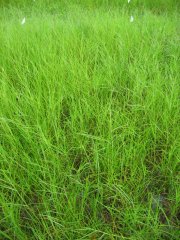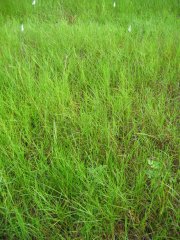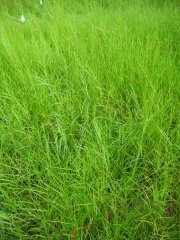Hemarthria and Herbicides
I have had several questions concerning limpograss (Hemarthria) tolerance to various herbicides. Dicamba (Banvel) has been the standard recommendation for weed control in limpograss, because Weedmaster contains 2,4-D, which has been reported to cause significant limpograss injury. Over the past couple of years, we have had several herbicides labeled in the pasture market including: Cimarron, Telar, Pasturegard, Overdrive, and Milestone. Little information regarding the tolerance of limpograss to these herbicides has been recorded.
In a study initiated on 12 April, 2005, 2,4-D amine at 2, 4, and 8 pints/acre, Remedy at 1, 2, and 4 pints/acre, and Milestone at 3, 5, and 7 fluid ounces/acre resulted in no visual injury (chlorosis and necrosis) three months after application to either non-mowed or mowed (10 inch regrowth at application) limpograss. When not mowed prior to herbicide application, these herbicide treatments did not impact limpograss production 6 months after treatment. However, if mowed prior to herbicide treatment, a 17 to 23% yield reduction was observed from 4 and 8 pints of 2,4-D amine as well as 2 and 4 pints of Remedy. Milestone caused a 15%-30% yield reduction when limpograss was mowed prior to application.
The lack of limpograss injury from applying 2 pints of 2,4-D was surprising. Therefore, a second study was initiated on 16 September, 2005. Cimarron at 0.1, 0.2, and 0.4 oz/acre, Telar at 0.5 and 1.0 oz/acre, Pasturegard at 2, 3, and 4 pints/acre, Weedmaster at 1, 2, and 4 pints/acre, Banvel at 0.3, 0.5, and 1 pint/acre, 2,4-D amine at 0.8, 1.5, and 3.0 pints/acre, and Overdrive at 4 and 8 oz/acre were applied to 10 inch limpograss. Applications of Cimarron, Telar, Pasturegard at 2 and 3 pints, Banvel, 2,4-D at 0.75 pints, and WeedMaster at 1 and 2 pints caused less than 15% injury (chlorosis and necrosis) 1 month after treatment (See figures). By 2 months after treatment, no chlorosis or necrosis was present from any herbicide application. Although chlorosis was not present, limpograss height was reduced by at least 15% from applications of Pasturegard at 4 pints, 2,4-D at 3 pints, WeedMaster at 4 pints, and both rates of Overdrive. Biomass was not recorded in this study.
At this point in time, Overdrive should not be applied to limpograss as injury was too severe. However, Cimarron and Telar are additional options that can be considered. Pasturegard (<3 pints/acre) and Remedy (<2 pints/acre) may also be applied to limpograss if some initial injury can be tolerated. At this point in time, Milestone can be applied up to 7 fluid ounces/acre when limpograss growth is mature, but use caution when applying this herbicide to newly formed growth. Additionally, limpograss appears to be more tolerant than previously thought to 2,4-D amine as well as Weedmaster, but the effects of 2,4-D appear to vary under different environmental conditions. Therefore, 2,4-D-containing products should not be applied until the effects of 2,4-D on limpograss are fully understood. Also, keep in mind that new limpograss growth may be more susceptible to herbicide injury than more mature stands.
Herbicides often cause injury to desirable species. How much injury can be tolerated is usually up to the grower. However, removing weeds in a pasture will often outweigh the effects of an herbicide on forage production, especially when injury is less than 15%. We will continue investigating the effect of herbicide applications at different times of the year to gain a better understanding how herbicides affect limpograss production.
Figures

Figure 1. Untreated limpograss

Figure 2. Response of limpograss to 2 pints/acre of Pasturegard four weeks after treatment.

Figure 3. Response of limpograss to 0.5 pints/acre of Banvel four weeks after treatment. This rate of Banvel is the same amount that would be applied in 2 pints of Weedmaster.

Figure 4. Response of limpograss to 1.5 pints/acre of 2,4-D amine four weeks after treatment. This rate of 2,4-D is equal to the same amount of 2,4-D in 2 pints of Weedmaster.

